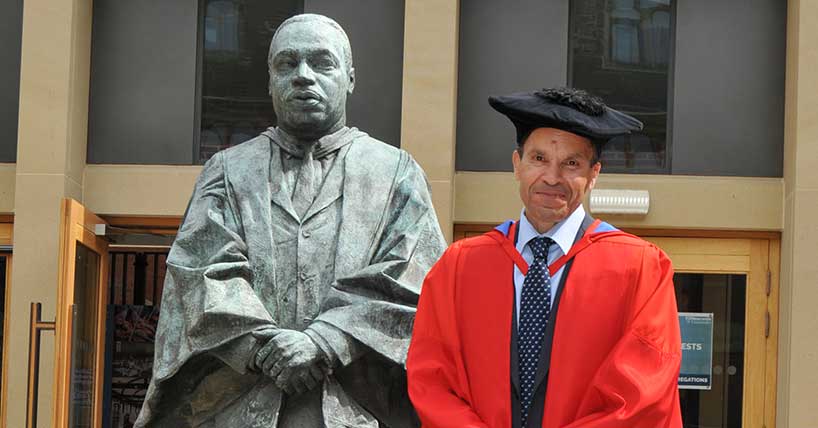Special relationship in turmoil
Comment: The special relationship thrown into turmoil by Trump
Published on: 13 July 2018
Writing for The Conversation, Dr Martin Farr discusses the recent history of the relationship between Britain and the US.
One of the few conventions Donald Trump has observed as president has been to venerate Winston Churchill. The intention was obvious therefore when on the evening of his arrival in the UK he was feted at Churchill’s birthplace, Blenheim Palace. Indeed, in the whole of his three days in Britain, the only time Trump was allocated to spend outside of a palace, a castle, or a golf course was be in a helicopter going between them – an arrangement not unlike the visit of the hitherto most unpopular American president, George W Bush.
Trump arrived in the UK at an extraordinarily sensitive moment. Britain is detaching itself from one of its two geo-strategic moorings, the EU, the other being the US. The importance of that relationship sent the prime minister, Theresa May, flying in haste (and to some ridicule) across the Atlantic to meet Trump as soon as he became president. She has now welcomed him in the midst of her latest, most serious, Brexit crisis – seeking support from the “special relationship”.
With massive protests planned weeks in advance, the plan was to keep the visit as tight and cloistered as possible. Given the guest, there were high expectations of the unexpected. But Trump has actually exceeded them.
In an interview with The Sun on July 12, Trump said May’s Brexit policy would “probably kill” a US-UK trade deal – a key ambition of Brexiters – the problem being, typically, that “she didn’t listen to me”. He then praised her recently departed foreign secretary as likely to “make a great prime minister”. The pageantry of the palace appears to have counted for little, and Theresa May has been placed in an impossible position like no prime minister before her.
Evidently enjoying the chaos he had created, in their joint meeting at Chequers Trump, by turns contradictory and incoherent, blamed “fake news” for stories of disagreement, and was at pains to state that their relationship was “very, very strong”, and that his visit was “really something”. At a joint press conference after their meeting, he clouded his original meaning: “Once the Brexit process is concluded and maybe the UK has left the EU … I don’t know what you’re gonna do, just make sure we can trade together, that’s all that matters.” To settle matters he assured the world that the special relationship was “the highest level of special”.
Trump’s earlier transgressions had become so well-known as to be a litany. He has retweeted Britain First, endorsed Nigel Farage for US ambassador, insulted the mayor of London and derided the location of America’s new London embassy. His latest interventions are nothing less than a calculated insult to the prime minister – a humiliation. One runs out of superlatives. Nothing like this has ever happened before.
To add to the general air of unreality, this was the first time the itinerary of a presidential visit has been published alongside a list of protests one can choose from. Still, the visit has its precedents.
Convention and choreography
Trump is the 12th US president to visit the UK while in office. Of the two-termers, Bill Clinton came six times, George W Bush five, Barack Obama and Ronald Reagan four, Richard Nixon three, and Dwight Eisenhower two. One-termers Jimmy Carter and George Bush each came once, though John F Kennedy managed two visits in his single foreshortened term. Before Kennedy, only two presidents had visited, both after shared victories in world war: Harry Truman on his way to Potsdam in August 1945, and Woodrow Wilson on his way to the Paris Peace Conference in December 1918.
Nixon’s first visit in 1969 was subject to protests against Vietnam – an American war a Labour prime minister had kept Britain out of (partly in consequence, Lyndon Johnson never came). George W. Bush visited in 2003 during another American war which had elicited a contrasting response from a different Labour prime minister.
It’s a reflection of the orientation of the respective political cultures that it’s only ever Republican presidents who are unpopular in Britain. The worst it got for a Democrat was the awkwardness of Clinton’s visit in February 1993 – and only then because of the John Major government’s rather injudicious preference for his opponent.
What united all of these visits was convention. Even when there were Anglo-American disagreements, there was at least diplomatic language and due process. Indeed, Trump’s behaviour is a challenge to norms of diplomacy, manners, even grammar: no previous president would have publicly described somewhere he was about to visit – much less a close ally – as “a situation with turmoil”. Such iconoclasm is of course, central to his appeal; his purpose.
Choreography has always been applied to add value to these visits: Reagan stayed at Windsor Castle, rode with the Queen and addressed both houses of Parliament, as did Obama and Clinton – who also attended a Cabinet meeting. The present president is a test of any choreographer.
Tearing up the rulebook
When one party to a diplomatic encounter appears to delight in subverting the norms of due process, personal diplomacy assumes greater significance – but Trump’s capriciousness presents another challenge when set against May’s uncommonly ordered personality. Yet however fashionable it is to deny it – and however confused or stilted Trump and May’s relationship might be – these two countries really do share a special relationship.
Britain and America’s commonalities – language, commerce, defence, foreign policy, intelligence, customs, culture – mean that, as close Obama adviser Ben Rhodes said this month, the UK and US never meet to negotiate, because the start and end points are the same: “That makes it a unique relationship that you don’t have with any other country.”
This is, perhaps, the greatest challenge for the prime minister: it’s no longer clear what start or end points the US and UK share. Indeed, as Trump has demonstrated since arriving, nobody knew what her guest would say on any given subject – possibly not even the guest himself.
It is an axiom of diplomacy to deal with the world as it is rather as one might like it to be, and it follows that the visit of any American president needs to be a welcoming one. But protesters have more power than they may realise: Trump had already cancelled one visit for fear of a humiliating reception, and no other president is so likely to feel slighted – even if, as a native New Yorker, Trump will be familiar with personalised blimps.
It seems an age since an American president - still living - visited the UK with minimal security, and was met by thousands of members of the public, cheering and waving. In rare continuity, this president has also attracted thousands of members of the public, with their hand gestures.
Martin Farr, Senior Lecturer in Modern and Contemporary British History, Newcastle University
This article was originally published on The Conversation. Read the original article.



